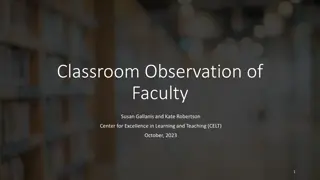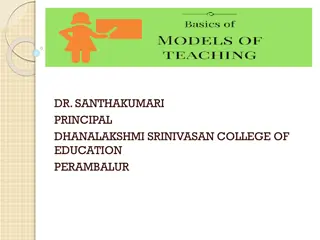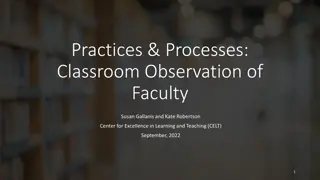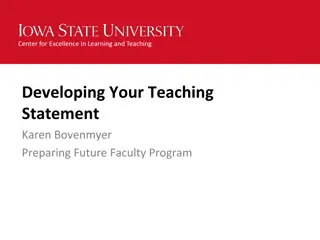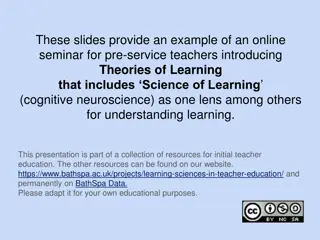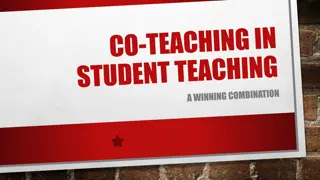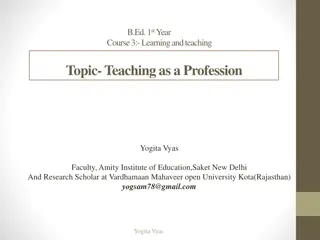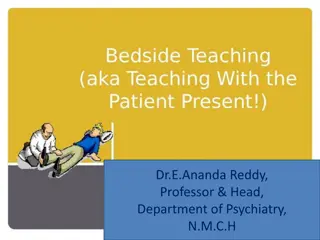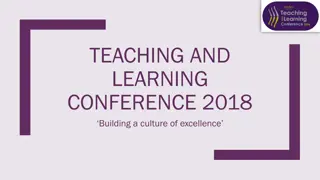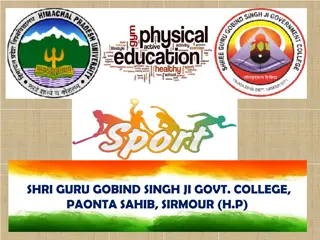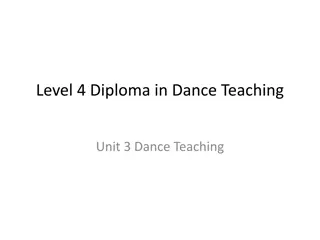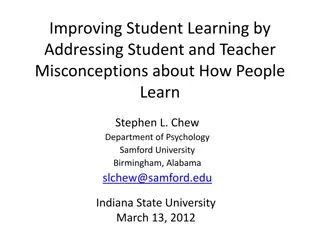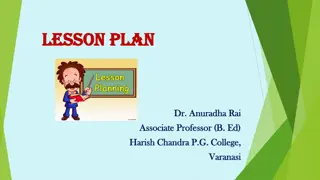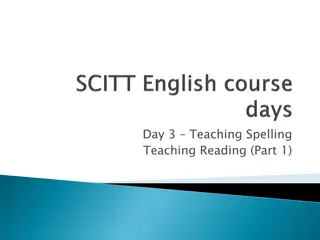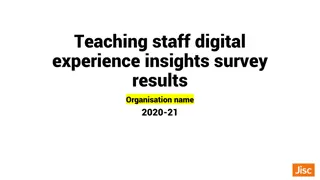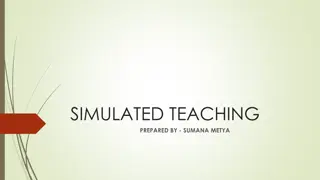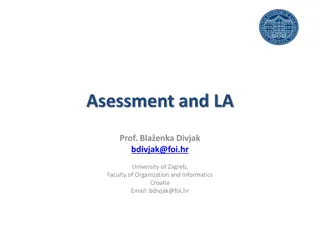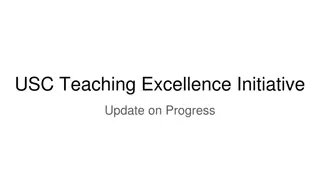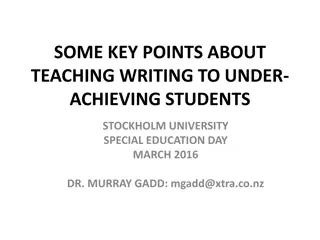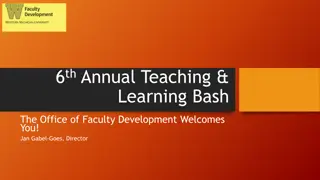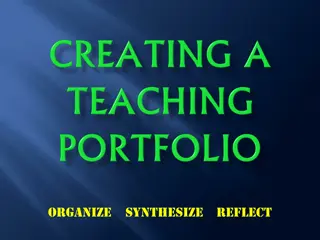
Effective Teaching/Learning Practices Overview
Explore the fundamentals of effective teaching/learning practices, including assessment, spaced learning, reciprocal teaching, and feedback. Learn about norms for professional development and the importance of pre-assessment in educational settings. Achieve outcomes such as defining effective practices, understanding their benefits, and planning for successful implementation while avoiding drift.
Download Presentation

Please find below an Image/Link to download the presentation.
The content on the website is provided AS IS for your information and personal use only. It may not be sold, licensed, or shared on other websites without obtaining consent from the author. If you encounter any issues during the download, it is possible that the publisher has removed the file from their server.
You are allowed to download the files provided on this website for personal or commercial use, subject to the condition that they are used lawfully. All files are the property of their respective owners.
The content on the website is provided AS IS for your information and personal use only. It may not be sold, licensed, or shared on other websites without obtaining consent from the author.
E N D
Presentation Transcript
P r o f e s s i o n a l D e v e l o p m e n t t o P r a c t i c e P r o f e s s i o n a l D e v e l o p m e n t t o P r a c t i c e Effective Teaching/Learning Practices An Overview This work is licensed under a Creative Commons Attribution-NonCommercial-NoDerivatives 4.0 International License. The contents of this presentation were developed under a grant from the US Department of Education to the Missouri Department of Elementary and Secondary Education (#H323A120018). However, these contents do not necessarily represent the policy of the US Department of Education, and you should not assume endorsement by the Federal Government.
P r o f e s s i o n a l D e v e l o p m e n t t o P r a c t i c e
P r o f e s s i o n a l D e v e l o p m e n t t o P r a c t i c e Effective Teaching/ Learning Practices (EP) Overview and Purpose of EP Overview and Purpose of Effective/ Learning Practices Assessment Capable Learners Spaced versus Massed Reciprocal Teaching Feedback
P r o f e s s i o n a l D e v e l o p m e n t t o P r a c t i c e Norms Be Respectful Be an active listener open to new ideas Use notes for side bar conversations Be Responsible Be on time for sessions Silence cell phones reply appropriately Bea Problem Solver Ask questions as needed to clarify concepts or directions
P r o f e s s i o n a l D e v e l o p m e n t t o P r a c t i c e Pre-Assessment Turn to pages 5 and 6 of your handout and complete the pre-assessment. * Handout: FINAL Revised Guided Notes with definitions and pre/post Effective Teaching/Learning Practices Overview 06032013
P r o f e s s i o n a l D e v e l o p m e n t t o P r a c t i c e Today s Outcomes By the end of the Effective Teaching/Learning Practices Overview, you will be able to: Define an effective teaching/learning practice and rationale for utilizing effective practices. Describe four Effective Teaching/Learning Practices and benefits of each. Understand that each practice aligns with the Missouri Teacher Standards. Explain how the Effective Teaching/Learning Practices will be implemented at the building, data team, and classroom levels. Plan key steps to avoid implementation and fidelity drift.
P r o f e s s i o n a l D e v e l o p m e n t t o P r a c t i c e Guided Notes Guided notes are provided to assist with your note taking throughout this presentation. This icon in the upper right corner of a slide is a prompt that there is information for your guided notes Handout: FINAL Revised Guided Notes with definitions and pre/post Effective Teaching/Learning Practices Overview 06032013 *
P r o f e s s i o n a l D e v e l o p m e n t t o P r a c t i c e Today s Outcomes By the end of the Effective Teaching/Learning Practices Overview, you will be able to: Define an effective teaching/learning practice and rationale for utilizing effective practices. Describe the four Effective Teaching/Learning Practices and benefits of each. Understand that each practice aligns with the Missouri Teacher Standards. Explain how the effective practices will be implemented at the building, data team, and classroom levels. Plan key steps to avoid implementation and fidelity drift.
P r o f e s s i o n a l D e v e l o p m e n t t o P r a c t i c e Definition of Effective Teaching/Learning Practices Effective Teaching/Learning Practices at the classroom level are evidence-based effective methods that are not content related and when implemented with fidelity and informed through data can produce positive, sustained results for every student.
P r o f e s s i o n a l D e v e l o p m e n t t o P r a c t i c e Why Use Effective Teaching/ Learning Practices? Research shows that the ways in which teachers promote ways of thinking through teaching practices can enhance students information processing, motivation for learning, and cognitive development. Ames & Archer (1988)
P r o f e s s i o n a l D e v e l o p m e n t t o P r a c t i c e Why Use Effective Teaching/ Learning Practices? Helping teachers create an instructional environment that effectively assists students to master their learning and do problem solving is important for early school successes and provides a basis for expanded school demands (p. 528). For teachers and educators, creating an academic environment based on learning practices is crucial to students learning. Mercer & Mercer (1998)
P r o f e s s i o n a l D e v e l o p m e n t t o P r a c t i c e Why Use Effective Teaching/Learning Practices? To make teaching and learning visible requires an accomplished teacher as evaluator and activator , who knows a range of learning strategiesto build the students surface knowledge, deep knowledge and understanding, and conceptual understanding (p. 18) Hattie (2012)
P r o f e s s i o n a l D e v e l o p m e n t t o P r a c t i c e In Your Own Words A colleague stops you in the hallway tomorrow morning and asks you what you learned today. You have one minute before going to bus duty. In your own words, develop a definition of an effective teaching/learning practice and rationale for using effective practices that you can share in less than a minute. Share your definition and rationale with a partner.
P r o f e s s i o n a l D e v e l o p m e n t t o P r a c t i c e Today s Outcomes By the end of the Effective Teaching/Learning Practices Overview, you will be able to: Define an effective teaching/learning practice and rationale for utilizing effective practices. Describe the four Effective Teaching/Learning Practices and benefits of each. Understand that each practice aligns with the Missouri Teacher Standards. Explain how the effective practices will be implemented at the building, data team, and classroom levels. Plan key steps to avoid implementation and fidelity drift.
P r o f e s s i o n a l D e v e l o p m e n t t o P r a c t i c e Which Four Effective Teaching/Learning Practices? The four Effective Teaching/Learning Practices for which we have materials and supports are highlighted. Assessment-Capable Learners (Self-Reported Grades) Reciprocal Teaching Feedback Spaced vs. Massed Practice
P r o f e s s i o n a l D e v e l o p m e n t t o P r a c t i c e P r o f e s s i o n a l D e v e l o p m e n t t o P r a c t i c e Assessment-Capable Learners (Self-Reported Grades) Definition Benefits Hattie Barometer Alignment to Missouri Teacher Standards The contents of this presentation were developed under a grant from the US Department of Education to the Missouri Department of Elementary and Secondary Education (#H323A120018). However, these contents do not necessarily represent the policy of the US Department of Education, and you should not assume endorsement by the Federal Government.
P r o f e s s i o n a l D e v e l o p m e n t t o P r a c t i c e Assessment-Capable Learners (Self-Reported Grades) Definition Assessment-Capable Learners (Self-Reported Grades) is an effective teaching/learning practice and is defined as students regulating and facilitating their own learningby accurately and appropriately answering the following questions: 1) Where am I going?; 2) Where am I now?; 3) How do I close the gap?. Adapted from S. Brookhart, (2012); J. Chappuis (2009); J. Hattie (2012), and J. Atkin, P. Black, &J. Coffey, (2001).
P r o f e s s i o n a l D e v e l o p m e n t t o P r a c t i c e Assessment-Capable Learners (Self-Reported Grades) Definition (cont.) Students have a clear understanding of the learning target; know where they are relative to mastery of the target based on descriptive feedback; set and monitor their own achievement goals; and know how they can revise or refine their performance to achieve that target. Adapted from S. Brookhart, (2012); J. Chappuis (2009); J. Hattie (2012), and J. Atkin, P. Black, &J. Coffey, (2001).
P r o f e s s i o n a l D e v e l o p m e n t t o P r a c t i c e Assessment-Capable Learners (Self-Reported Grades) Benefits A very efficient way to estimate students' knowledge gain is simply to ask students to rate how much they have learned in a given lesson or a set of lessons . . . . . Student self-reports on their learning is an easy and apparently legitimate way to obtain information in the course of walkthroughs or instructional rounds regarding student achievement within the context of a specific lesson or set of lessons. Marzano, R. J. (2009)
P r o f e s s i o n a l D e v e l o p m e n t t o P r a c t i c e Assessment-Capable Learners (Self-Reported Grades) 6 meta-analyses, 209 studies, Rank 1st (Self-Reported Grades) (1.44 effect size) Hattie, J. (2009). Visible Learning. New York: Routledge Hattie, J. (2012). Visible Learning for Teaachers. New York: Routledge
P r o f e s s i o n a l D e v e l o p m e n t t o P r a c t i c e Assessment-Capable Learners (Self-Reported Grades) and Missouri Teacher Standards Assessment-Capable Learners (Self-Reported Grades) aligns with the following Missouri Teacher Standards: Standard 2, Quality Indicator 2 Standard 6, Quality Indicator 4 Standard 7, Quality Indicators 2 & 3
P r o f e s s i o n a l D e v e l o p m e n t t o P r a c t i c e Assessment-Capable Learners (Self-Reported Grades) and Missouri Teacher Standards Standard 2: Student Learning, Growth and Development 2.2: Student Goals Standard 6: Effective Communication 6.4: Technology and media communication tools Standard 7: Student Assessment and Data Analysis 7.2: Assessment data to improve learning 7.3: Student-led assessment strategies
P r o f e s s i o n a l D e v e l o p m e n t t o P r a c t i c e P r o f e s s i o n a l D e v e l o p m e n t t o P r a c t i c e Reciprocal Teaching Definition Benefits Hattie Barometer Alignment to Missouri Teacher Standards The contents of this presentation were developed under a grant from the US Department of Education to the Missouri Department of Elementary and Secondary Education (#H323A120018). However, these contents do not necessarily represent the policy of the US Department of Education, and you should not assume endorsement by the Federal Government.
P r o f e s s i o n a l D e v e l o p m e n t t o P r a c t i c e Reciprocal Teaching Definition Reciprocal Teaching is an effective teaching/learning practice and is defined as students summarizing, questioning, clarifying, and predicting; they take turns being the teacher.
P r o f e s s i o n a l D e v e l o p m e n t t o P r a c t i c e Reciprocal Teaching Benefit Reciprocal teaching (RT) is an instructional procedure developed by Palincsar and Brown (1984) to improve students text comprehension skills through scaffolded instruction of four comprehension-fostering and comprehension-monitoring strategies (Palincsar & Brown, 1984; Palincsar, David, & Brown, 1989; Rosenshine & Meister, 1994), that is, (a) generating one s own questions, (b) summarizing parts of the text, (c) clarifying word meanings and confusing text passages, and (d) predicting what might come next in the text. Sp rer, N., Brunstein, J. C., & Kieschke, U. (2009)
P r o f e s s i o n a l D e v e l o p m e n t t o P r a c t i c e Reciprocal Teaching 2 meta-analyses, 38 studies, Rank 9th .74 effect size
P r o f e s s i o n a l D e v e l o p m e n t t o P r a c t i c e Reciprocal Teaching and Missouri Teacher Standards Reciprocal Teaching aligns with the following Missouri Teacher Standards: Standard 1, Quality Indicators 1 & 4 Standard 4, Quality Indicator 3 Standard 6, Quality Indicators 3 & 4 Standard 7, Quality Indicator 3
P r o f e s s i o n a l D e v e l o p m e n t t o P r a c t i c e Reciprocal Teaching and Missouri Teacher Standards Standard 1: Content knowledge aligned with appropriate instruction. 1.1: Content knowledge and academic language 1.4: Interdisciplinary instruction Standard 4: Teaching for Critical Thinking 4.3: Cooperative, small group and independent learning Standard 6: Effective Communication 6.3: Learner expression in speaking, writing and other media 6.4: Technology and media communication tools Standard 7: Student Assessment and Data Analysis 7.3 Student-led assessment strategies
P r o f e s s i o n a l D e v e l o p m e n t t o P r a c t i c e P r o f e s s i o n a l D e v e l o p m e n t t o P r a c t i c e Feedback Definition Benefits Hattie Barometer Alignment to Missouri Teacher Standards The contents of this presentation were developed under a grant from the US Department of Education to the Missouri Department of Elementary and Secondary Education (#H323A120018). However, these contents do not necessarily represent the policy of the US Department of Education, and you should not assume endorsement by the Federal Government.
P r o f e s s i o n a l D e v e l o p m e n t t o P r a c t i c e Feedback Definition Feedback is an effective teaching/learning practice and is defined as an integral aspect of instruction and learning utilizing information provided by an agent (e.g. teacher, peer, book, parent, self/experience, computer) regarding aspects of one s performance or understanding. The main purpose of feedback is to reduce discrepancies between current understanding or performance and some desired level of performance or goal.
P r o f e s s i o n a l D e v e l o p m e n t t o P r a c t i c e Feedback includes feedback to students as well as FROM students in terms of what students know, what they understand, and when they have misconceptions. Feedback is essential to Visible Learning which, according to Hattie, occurs When teachers SEE learning through the eyes of the student AND when students SEE themselves as their own teachers. visiblelearningplus.com
P r o f e s s i o n a l D e v e l o p m e n t t o P r a c t i c e Feedback Benefit . . . the main purpose of feedback to be to reduce discrepancies between current understanding or performance and some desired level of performance or goal. Voerman, L., Meijer, P. C., Korthagen, F. A., & Simons, R. J. (2012)
P r o f e s s i o n a l D e v e l o p m e n t t o P r a c t i c e Feedback 23 meta-analyses, 1287 studies, Rank 10th .73 effect size
P r o f e s s i o n a l D e v e l o p m e n t t o P r a c t i c e Feedback and Missouri Teacher Standards Feedback aligns with the following Missouri Teacher Standards: Standard 1, Quality Indicator 2 Standard 2, Quality Indicators 2 & 5 Standard 6, Quality Indicators 2 & 4 Standard 7, Quality Indicators 1, 2, 3, 4, & 5
P r o f e s s i o n a l D e v e l o p m e n t t o P r a c t i c e Feedback and Missouri Teacher Standards Standard 1: Content knowledge aligned with appropriate instruction. 1.2: Student engagement in subject matter Standard 2: Student Learning, Growth and Development 2.2: Student goals 2.5: Prior experiences, learning styles, multiple intelligences, strengths and needs Standard 6: Effective Communication 6.2: Sensitivity to culture, gender, intellectual and physical differences 6.4: Technology and media communication tools Standard 7: Student Assessment and Data Analysis 7.1: Effective use of assessments 7.2: Assessment data to improve learning 7.3: Student-led assessment strategies 7.4: Effect of instruction on individual/class learning 7.5: Communication of student progress and maintaining records
P r o f e s s i o n a l D e v e l o p m e n t t o P r a c t i c e P r o f e s s i o n a l D e v e l o p m e n t t o P r a c t i c e Spaced vs. Massed Practice Definition Description/Rationale Hattie Barometer Alignment to Missouri Teacher Standards The contents of this presentation were developed under a grant from the US Department of Education to the Missouri Department of Elementary and Secondary Education (#H323A120018). However, these contents do not necessarily represent the policy of the US Department of Education, and you should not assume endorsement by the Federal Government.
P r o f e s s i o n a l D e v e l o p m e n t t o P r a c t i c e Spaced vs. Massed Practice Definition Spaced vs. Massed Practice is an effective teaching/learning practice and is defined as spaced practice being those conditions in which individuals are given rest intervals within the practice session and massed practice being those conditions in which individuals practice a task continuously without rest. Adapted from J. Donovan & D. Radosevich (1999).
P r o f e s s i o n a l D e v e l o p m e n t t o P r a c t i c e Spaced vs. Massed Practice Benefit Repetition of information improves learning and memory. No surprise there. However, how information is repeated determines the amount of improvement. If information is repeated back to back (massed or blocked presentation), it is often learned quickly but not very securely (i.e., the knowledge fades fast). If information is repeated in a distributed fashion or spaced over time, it is learned more slowly but is retained for much longer. Roediger III, H. L., & Pyc, M. A. (2012)
P r o f e s s i o n a l D e v e l o p m e n t t o P r a c t i c e Spaced vs. Massed Practice 2 meta-analyses, 63 studies, Rank 12th .71 effect size
P r o f e s s i o n a l D e v e l o p m e n t t o P r a c t i c e Spaced vs. Massed Practice and Missouri Teacher Standards Spaced vs. Massed Practice aligns with the following Missouri Teacher Standards: Standard 1, Quality Indicator 2 Standard 2, Quality Indicator 3 Standard 6, Quality Indicator 4
P r o f e s s i o n a l D e v e l o p m e n t t o P r a c t i c e Spaced vs. Massed Practice and Missouri Teacher Standards Standard 1: Content knowledge aligned with appropriate instruction. 1.2: Student engagement in subject matter Standard 2: Student Learning, Growth and Development 2.3: Theory of learning Standard 6: Effective Communication 6.4: Technology and media communication tools
P r o f e s s i o n a l D e v e l o p m e n t t o P r a c t i c e Which Practice? This practice has an effect size of 0.71 and refers to how a teacher schedules practice of new learning for maximum retention. In this practice, student comprehension is increased through summarizing, questioning, clarifying, and predicting. The students take turns being the teacher. This practice is literally off the scale with effect size; students regulate and facilitate their own learning. This practice helps students understand their current performance in relationship to a desired level of performance.
P r o f e s s i o n a l D e v e l o p m e n t t o P r a c t i c e Today s Outcomes By the end of the Effective Teaching/Learning Practice Overview, you will be able to: Define an effective teaching/learning practice and rationale for utilizing effective practices. Describe the four Effective Teaching/Learning Practices and benefits of each. Understand that each practice aligns with the Missouri Teacher Standards. Explain how the effective practices will be implemented at the building, data team, and classroom levels. Plan key steps to avoid implementation and fidelity drift.
P r o f e s s i o n a l D e v e l o p m e n t t o P r a c t i c e P r o f e s s i o n a l D e v e l o p m e n t t o P r a c t i c e Effective Teaching/Learning Practice Building, Data Team, and Classroom Implementation The contents of this presentation were developed under a grant from the US Department of Education to the Missouri Department of Elementary and Secondary Education (#H323A120018). However, these contents do not necessarily represent the policy of the US Department of Education, and you should not assume endorsement by the Federal Government.
P r o f e s s i o n a l D e v e l o p m e n t t o P r a c t i c e The teacher must know when learning is correct or incorrect; learn when to experiment and learn from the experience; learn to monitor, seek and give feedback; and know to try alternative learning strategies when others do not work (p. 25). Hattie (2009)
P r o f e s s i o n a l D e v e l o p m e n t t o P r a c t i c e Each Grade Level Team or Teacher Will: Identify a content area of English Language Arts or Mathematics to focus their attention and to report progress. Select one or two Effective Teaching/Learning Practice(s) for the year that all teachers will agree to start using.
P r o f e s s i o n a l D e v e l o p m e n t t o P r a c t i c e The Teacher Will: Select the appropriate teaching/learning practice that meets the instructional needs of all students in his/her classroom based on data. Demonstrate proficiency (knowledge and skills) to implement the selected teaching/learning practice. Implement the selected teaching/learning practice with fidelity. Monitor learning and make changes to the teaching/learning practice as needed.
P r o f e s s i o n a l D e v e l o p m e n t t o P r a c t i c e Teacher/Classroom Level What data will teachers use to select the instructional practice for their classrooms? How will you know: that teachers have proficiency in the instructional practice? that the instructional practice is implemented with fidelity? that appropriate changes are made based on data?
P r o f e s s i o n a l D e v e l o p m e n t t o P r a c t i c e Today s Outcomes By the end of the Effective Teaching/Learning Practices Overview, you will be able to: Define an effective teaching/learning practice and rationale for utilizing effective practices. Describe the four Effective Teaching/Learning Practices and benefits of each. Understand that each practice aligns with the Missouri Teacher Standards. Explain how the effective practices will be implemented at the building, data team, and classroom levels. Plan key steps to avoid implementation and fidelity drift.
P r o f e s s i o n a l D e v e l o p m e n t t o P r a c t i c e P r o f e s s i o n a l D e v e l o p m e n t t o P r a c t i c e Effective Teaching/Learning Practices Avoiding Implementation and Fidelity Drift The contents of this presentation were developed under a grant from the US Department of Education to the Missouri Department of Elementary and Secondary Education (#H323A120018). However, these contents do not necessarily represent the policy of the US Department of Education, and you should not assume endorsement by the Federal Government.

